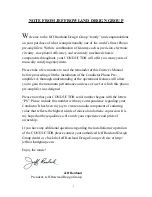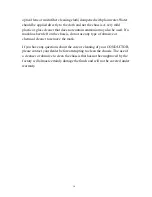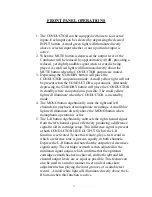
7. An optional handheld wired remote control box can be plugged
into the rear panel of the CONDUCTOR to provide different
equalization curves for playback of selected vintage recordings.
8. A two-pole (12 dB/octave) maximally flat high-pass filter is
incorporated into the signal path for filtering out undesirable low
frequency turntable rumble signals. An internal switch is provided
to insert an additional filter, which working in conjunction with the
two-pole filter, provides an additional attenuation greater than 40
dB at 10 Hertz, a common tone-arm resonance frequency. The
composite effect of these filters will have a minimal result on the
audio pass-band with less than 3 dB of attenuation at 20 Hertz.
9. Any MC input can be modified for higher gain for use with low
output phono cartridges. An additional 6 dB of gain is available.
The gain increase is accomplished by connecting the input
transformer primary windings in parallel for a higher turns ratio
over standard. This allows extra gain without a significant increase
of overall noise. A soldered jumper provides this change without
compromising signal integrity.
10.Front panel push buttons provide selection of Input, Mute,
Standby, Mono and Left minus Right functions. Functional
definitions of these buttons will be covered in the Operation
section of this manual.
11.The CONDUCTOR can be powered with two different external
power supplies. For users that own the optional JRDG Model PSU
power supply, the CONDUCTOR can be plugged into one of the
unused PSU auxiliary DC outputs. The Model PPS-1 DC Power
Supply can also be used to power the CONDUCTOR via its DC
output connector. Both power supply options provide a fully
regulated, low noise direct current power source for the
CONDUCTOR and are designed to be switched on and off via the
CONDUCTOR front panel Standby push button.
12.All of the active circuitry is elastomerically mounted within a
chassis machined from a solid block of aircraft grade 6061 bar-
stock aluminum, providing resonance control and shielding from
external radio frequency interference. Each input amplifier/
equalizer and output circuits are configured as individual
“modules”, which can be exchanged, updated or modified as
needed. All circuitry is strategically placed for the smallest
possible “loop area”, utilizing precision 0.1% thin-film surface
mount (SMD) componentry on four layer circuit boards for the
!
6






































